Abstract
The possibility that Ca2+ ions are involved in the control of the increased phosphatidylinositol turnover which is provoked by alpha-adrenergic or muscarinic cholinergic stimulation of rat parotid-gland fragments has been investigated. Both types of stimulation provoked phosphatidylinositol breakdown, which was detected either chemically or radiochemically, and provoked a compensatory synthesis of the lipid, detected as an increased rate of incorporation of 32Pi into phosphatidylinositol. Acetylcholine had little effect on the incorporation of labelled glycerol, whereas adrenaline stimulated it significantly, but to a much lower extent than 32P incorporation: this suggests that the response to acetylcholine was entirely accounted for by renewal of the phosphorylinositol head-group of the lipid, but that some synthesis de novo was involved in the response to adrenaline. The responses to both types of stimulation, whether measured as phosphatidylinositol breakdown or as phosphatidylinositol labelling, occurred equally well in incubation media containing 2.5 mm-Ca2+ or 0.2 mm-EGTA [ethanedioxybis(ethylamine)-tetra-acetic acid]. Incubation with a bivalent cation ionophore (A23187) led to a small and more variable increase in phosphatidylinositol labelling with 32Pi, which occurred whether or not Ca2+ was available in the extracellular medium: this was not accompanied by significant phosphatidylinositol breakdown. Cinchocaine, a local anaesthetic, produced parallel increases in the incorporation of Pi and glycerol into phosphatidylinositol. This is compatible with its known ability to inhibit phosphatidate phosphohydrolase (EC 3.1.3.4) and increase phosphatidylinositol synthesis de novo in other cells. These results indicate that the phosphatidylinositol turnover evoked by alpha-adrenergic or muscarinic cholinergic stimuli in rat parotid gland probably does not depend on an influx of Ca2+ into the cells in response to stimulation. This is in marked contrast with the K+ efflux from this tissue, which is controlled by the same receptors, but is strictly dependent on the presence of extracellular Ca2+. The Ca2+-independence of stimulated phosphatidylinositol metabolism may mean that it is controlled through a mode of receptor function different from that which controls other cell responses. Alternatively, it can be interpreted as indicating that stimulated phosphatidylinositol breakdown is intimately involved in the mechanisms of action of alpha-adrenergic and muscarinic cholinergic receptor systems.
Full text
PDF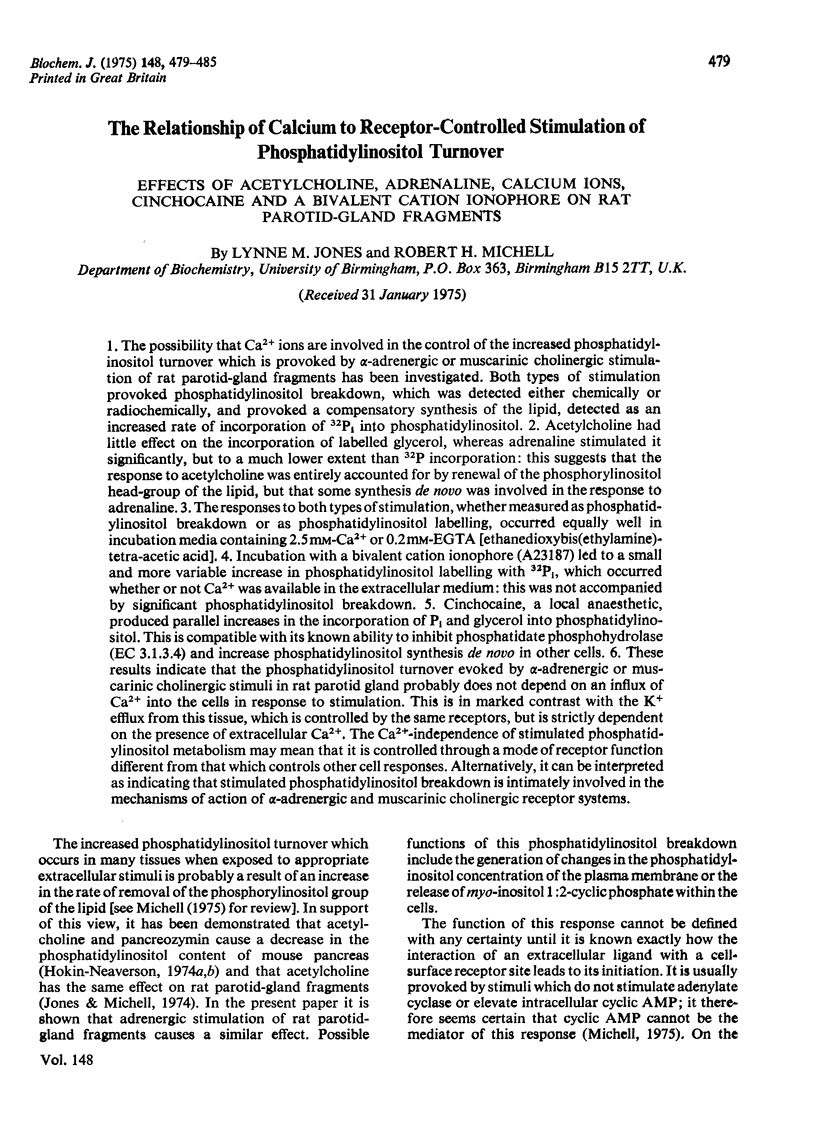
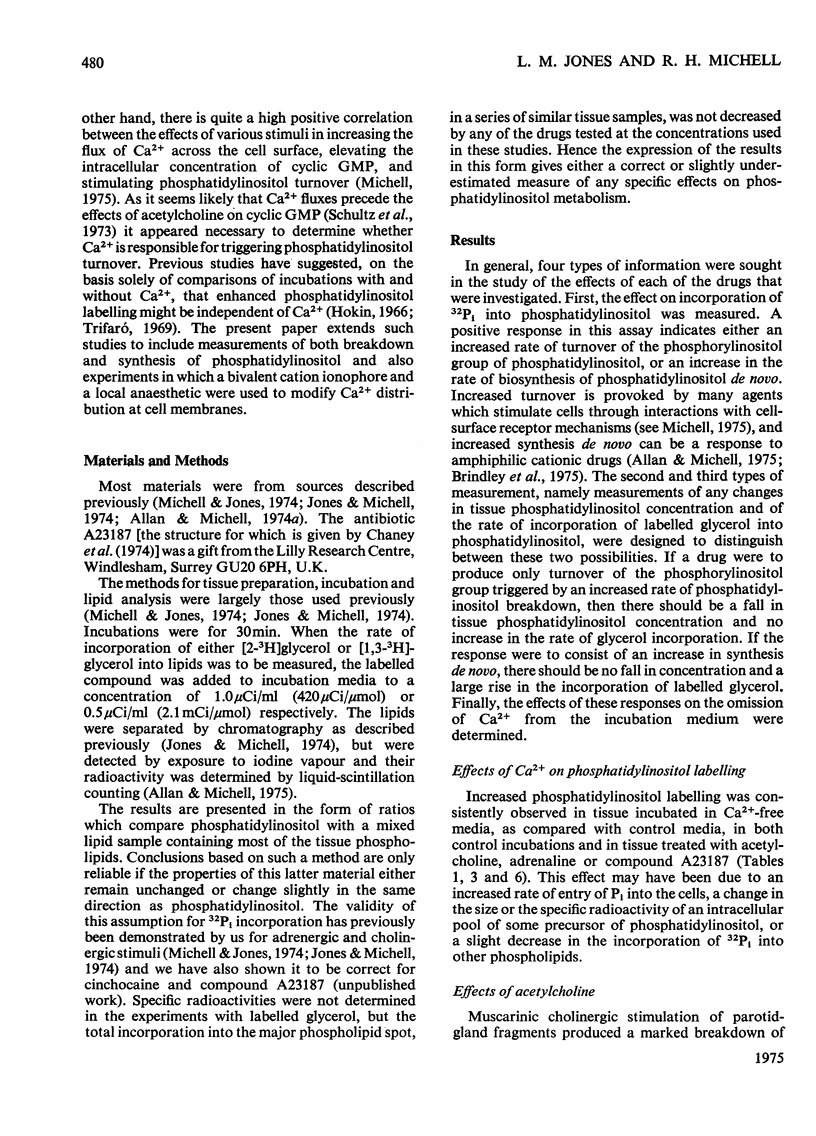
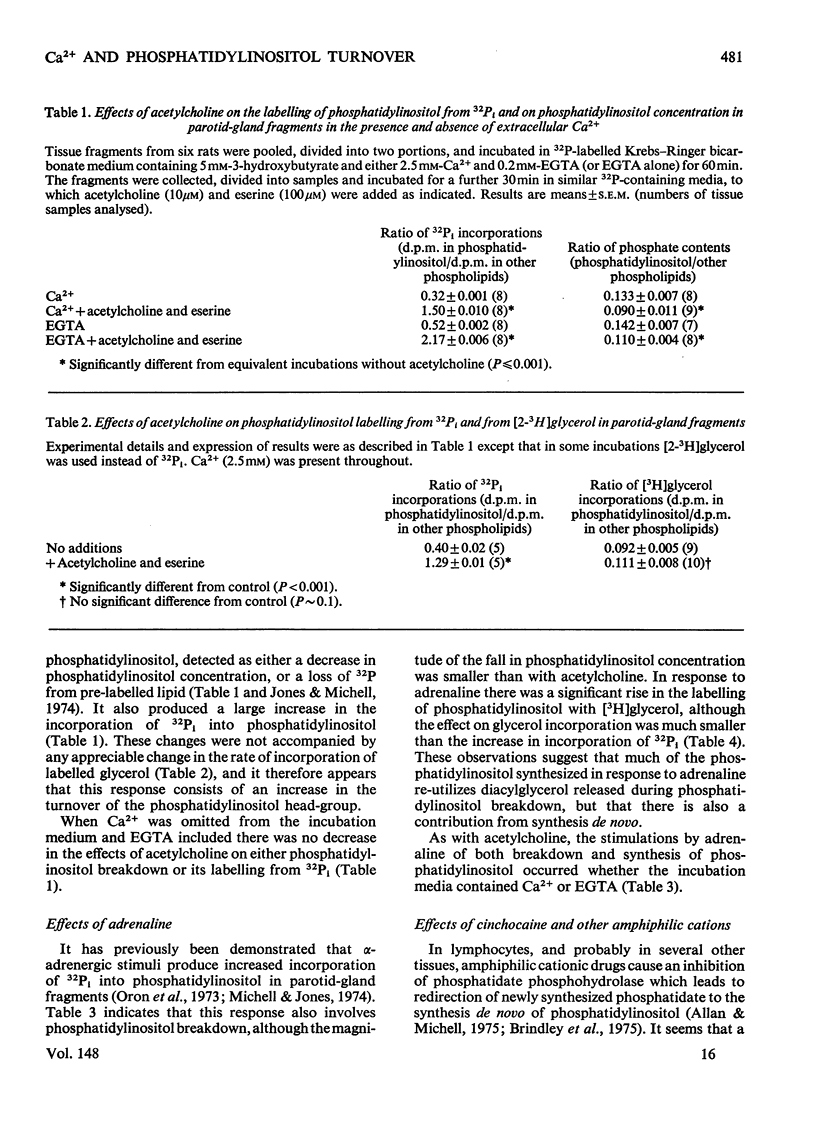
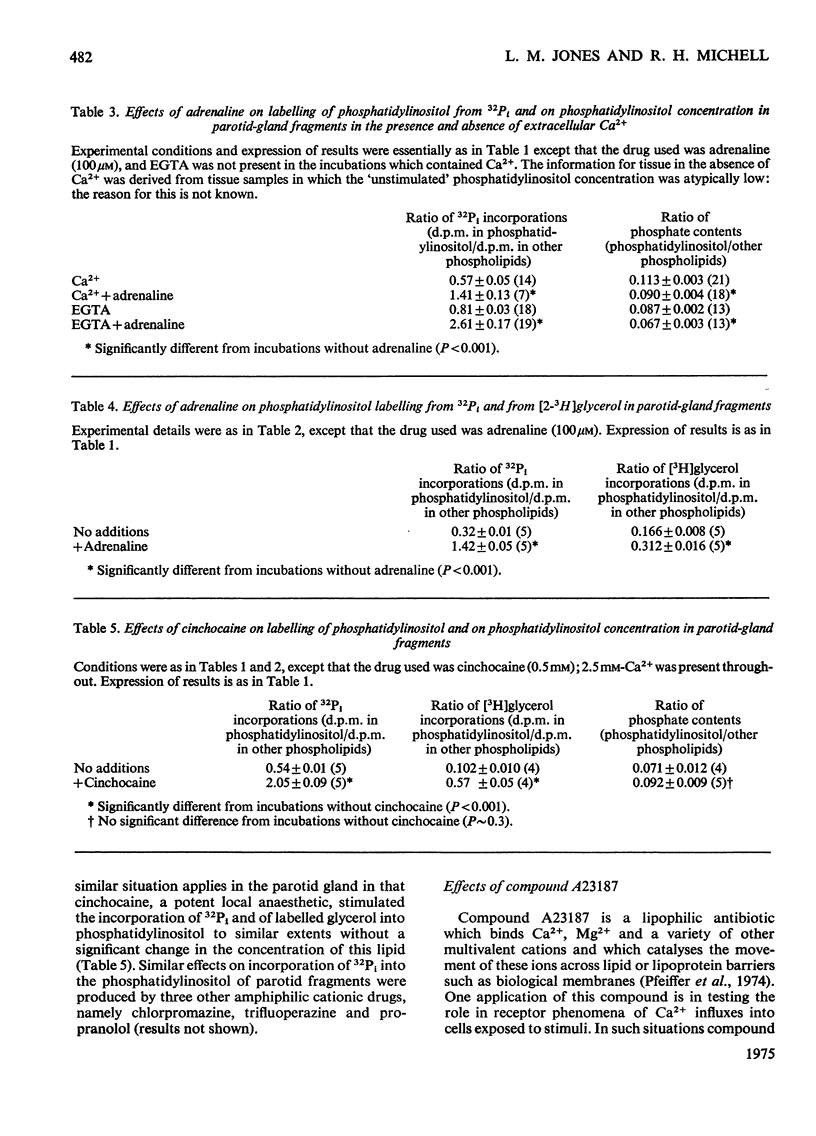
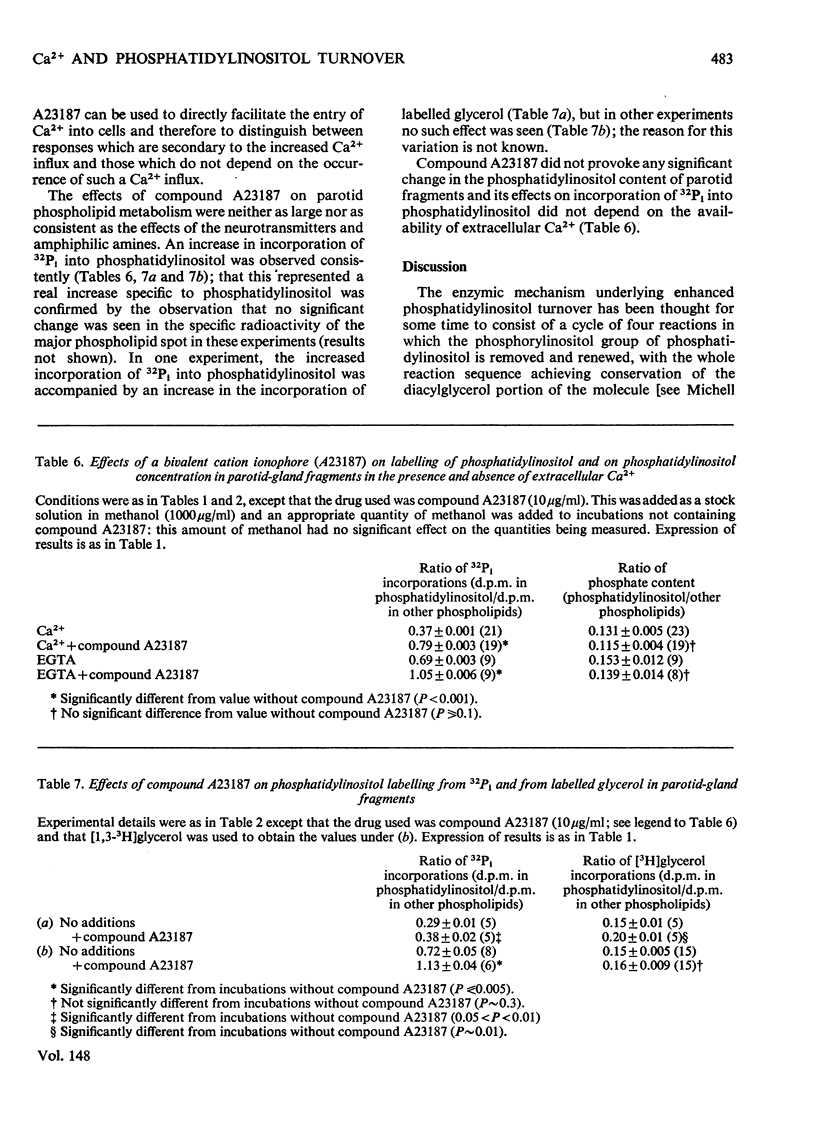
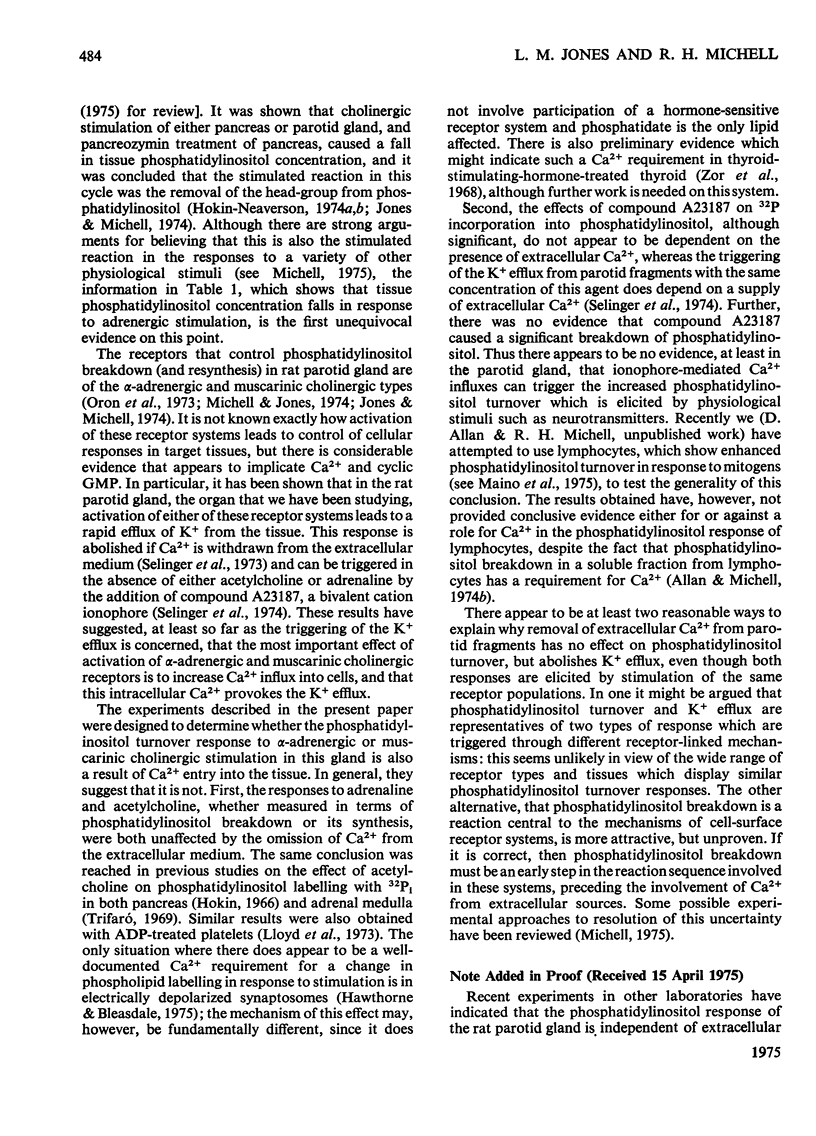
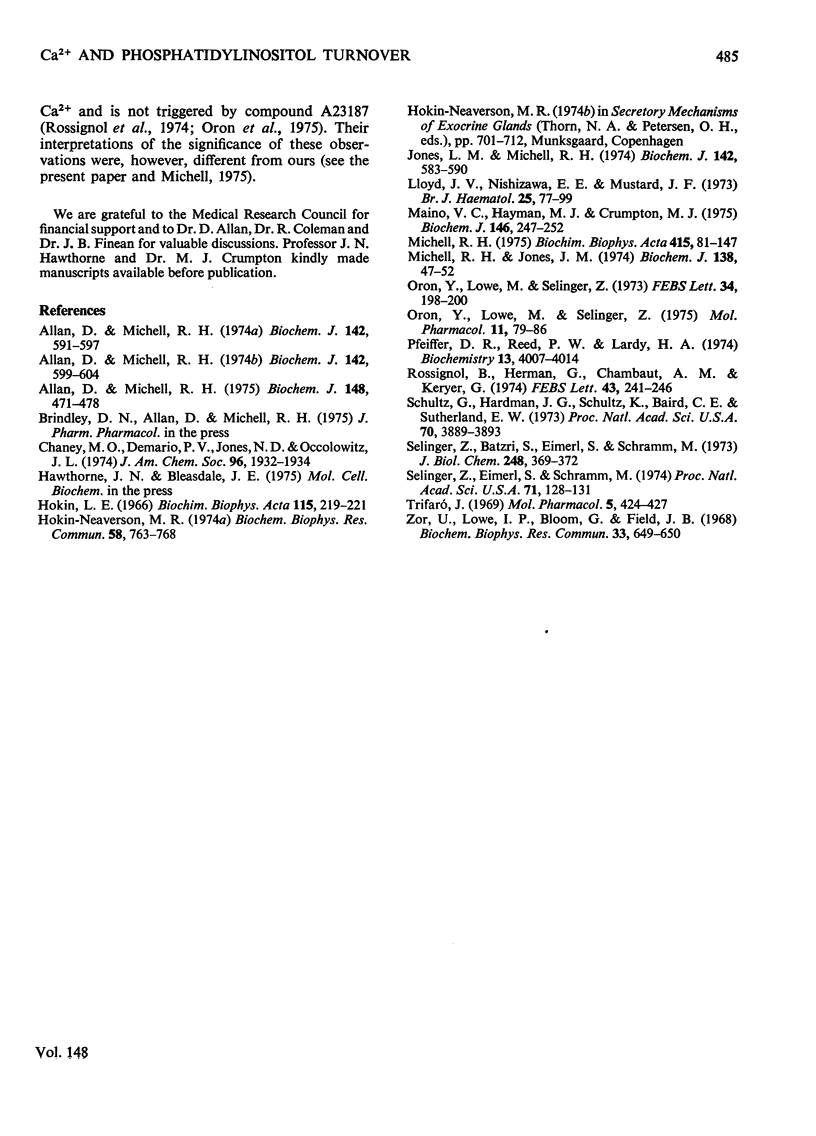
Selected References
These references are in PubMed. This may not be the complete list of references from this article.
- Allan D., Michell R. H. Enhanced synthesis de novo of phosphatidylinositol in lymphocytes treated with cationic amphiphilic drugs. Biochem J. 1975 Jun;148(3):471–478. doi: 10.1042/bj1480471. [DOI] [PMC free article] [PubMed] [Google Scholar]
- Allan D., Michell R. H. Phosphatidylinositol cleavage catalysed by the soluble fraction from lymphocytes. Activity at pH5.5 and pH7.0. Biochem J. 1974 Sep;142(3):591–597. doi: 10.1042/bj1420591. [DOI] [PMC free article] [PubMed] [Google Scholar]
- Allan D., Michell R. H. Phosphatidylinositol cleavage in lymphocytes. Requirement for calcium ions at a low concentration and effects of other cations. Biochem J. 1974 Sep;142(3):599–604. doi: 10.1042/bj1420599. [DOI] [PMC free article] [PubMed] [Google Scholar]
- Chaney M. O., Demarco P. V., Jones N. D., Occolowitz J. L. Letter: The structure of A23187, a divalent cation ionophore. J Am Chem Soc. 1974 Mar 20;96(6):1932–1933. doi: 10.1021/ja00813a047. [DOI] [PubMed] [Google Scholar]
- Hokin-Neaverson M. Acetylcholine causes a net decrease in phosphatidylinositol and a net increase in phosphatidic acid in mouse pancreas. Biochem Biophys Res Commun. 1974 Jun 4;58(3):763–768. doi: 10.1016/s0006-291x(74)80483-3. [DOI] [PubMed] [Google Scholar]
- Hokin L. E. Effects of calcium omission on acetylcholine-stimulated amylase secretion and phospholipid synthesis in pigeon pancreas slices. Biochim Biophys Acta. 1966 Jan 25;115(1):219–221. doi: 10.1016/0304-4165(66)90066-3. [DOI] [PubMed] [Google Scholar]
- Jones L. M., Michell R. H. Breakdown of phosphatidylinositol provoked by muscarinic cholinergic stimulation of rat parotid-gland fragments. Biochem J. 1974 Sep;142(3):583–590. doi: 10.1042/bj1420583. [DOI] [PMC free article] [PubMed] [Google Scholar]
- Lloyd J. V., Nishizawa E. E., Mustard J. F. Effect of ADP-induced shape change on incorporation of 32P into platelet phosphatidic acid and mono-, di- and triphosphatidyl inositol. Br J Haematol. 1973 Jul;25(1):77–99. doi: 10.1111/j.1365-2141.1973.tb01718.x. [DOI] [PubMed] [Google Scholar]
- Maino V. C., Hayman M. J., Crumpton M. J. Relationship between enhanced turnover of phosphatidylinositol and lymphocyte activation by mitogens. Biochem J. 1975 Jan;146(1):247–252. doi: 10.1042/bj1460247. [DOI] [PMC free article] [PubMed] [Google Scholar]
- Michell R. H. Inositol phospholipids and cell surface receptor function. Biochim Biophys Acta. 1975 Mar 25;415(1):81–47. doi: 10.1016/0304-4157(75)90017-9. [DOI] [PubMed] [Google Scholar]
- Michell R. H., Jones L. M. Enhanced phosphatidylinositol labelling in rat parotid fragments exposed to alpha-adrenergic stimulation. Biochem J. 1974 Jan;138(1):47–52. doi: 10.1042/bj1380047. [DOI] [PMC free article] [PubMed] [Google Scholar]
- Oron Y., Lowe M., Selinger Z. Involvement of the alpha-adrenergic receptor in the phospholipid effect in rat parotid. FEBS Lett. 1973 Aug 15;34(2):198–200. doi: 10.1016/0014-5793(73)80792-6. [DOI] [PubMed] [Google Scholar]
- Oron Y., Löwe M., Selinger Z. Incorporation of inorganic [32P] phosphate into rat parotid phosphatidylinositol. Induction through activation of alpha adrenergic and cholinergic receptors and relation to K+ release. Mol Pharmacol. 1975 Jan;11(1):79–86. [PubMed] [Google Scholar]
- Pfeiffer D. R., Reed P. W., Lardy H. A. Ultraviolet and fluorescent spectral properties of the divalent cation ionophore A23187 and its metal ion complexes. Biochemistry. 1974 Sep 10;13(19):4007–4014. doi: 10.1021/bi00716a029. [DOI] [PubMed] [Google Scholar]
- Rossignol B., Herman G., Chambaut A. M., Keryer G. The calcium ionophore A 23 187 as a probe for studying the role of Ca2+ ions in the mediation of carbachol effects on rat salivary glands: protein secretion and metabolism of phospholipids and glycogen. FEBS Lett. 1974 Jul 15;43(2):241–246. doi: 10.1016/0014-5793(74)81010-0. [DOI] [PubMed] [Google Scholar]
- Schultz G., Hardman J. G., Schultz K., Baird C. E., Sutherland E. W. The importance of calcium ions for the regulation of guanosine 3':5'-cyclic monophosphage levels. Proc Natl Acad Sci U S A. 1973 Dec;70(12):3889–3893. doi: 10.1073/pnas.70.12.3889. [DOI] [PMC free article] [PubMed] [Google Scholar]
- Selinger Z., Batzri S., Eimerl S., Schramm M. Calcium and energy requirements for K + release mediated by the epinephrine -receptor in rat parotid slices. J Biol Chem. 1973 Jan 10;248(1):369–372. [PubMed] [Google Scholar]
- Selinger Z., Eimerl S., Schramm M. A calcium ionophore simulating the action of epinephrine on the alpha-adrenergic receptor. Proc Natl Acad Sci U S A. 1974 Jan;71(1):128–131. doi: 10.1073/pnas.71.1.128. [DOI] [PMC free article] [PubMed] [Google Scholar]
- Trifaró J. M. The effect of Ca++ omission on the secretion of catecholamines and the incorporation of orthophosphate-32P into nucleotides and phospholipids of bovine adrenal medulla during acetylcholine stimulation. Mol Pharmacol. 1969 Jul;5(4):424–427. [PubMed] [Google Scholar]
- Zor U., Lowe I. P., Bloom G., Field J. B. The role of calcium (Ca++) in TSH and dibutyryl 3'5' cyclic AMP stimulation of thyroid glucose oxidation and phospholipid synthesis. Biochem Biophys Res Commun. 1968 Nov 25;33(4):649–658. doi: 10.1016/0006-291x(68)90345-8. [DOI] [PubMed] [Google Scholar]


